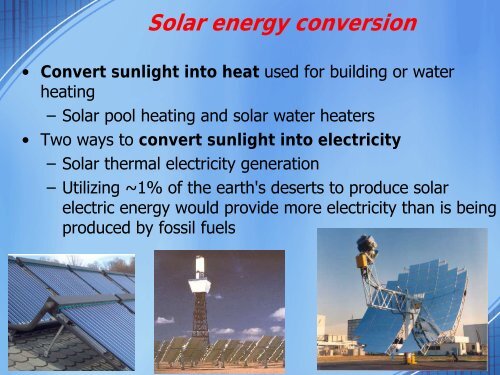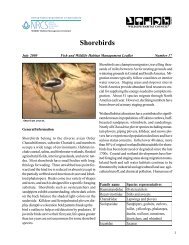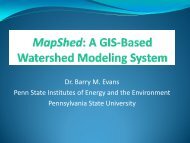Convert Sunlight Into Heat
Convert Sunlight Into Heat
Convert Sunlight Into Heat
Create successful ePaper yourself
Turn your PDF publications into a flip-book with our unique Google optimized e-Paper software.
Solar energy conversion<br />
• <strong>Convert</strong> sunlight into heat used for building or water<br />
heating<br />
– Solar pool heating and solar water heaters<br />
• Two ways to convert sunlight into electricity<br />
– Solar thermal electricity generation<br />
– Utilizing ~1% of the earth's deserts to produce solar<br />
electric energy would provide more electricity than is being<br />
produced by fossil fuels<br />
1
Photovoltaics - Simple explanation<br />
• 1. Photons (sunlight) hit the solar panel and are<br />
absorbed by semiconducting materials.<br />
• 2. Electrons (negatively charged) are knocked loose from<br />
their atoms, allowing them to flow through the material<br />
to produce electricity. Complementary positive charges<br />
are also created (holes) and flow in the direction opposite<br />
of the electrons.<br />
2
Solar cell fundamentals<br />
• Over 95 % of all solar cells are made from Silicon (Si).<br />
• Dope Si fort solar cell production.<br />
• Positive charge carriers (p-doped).<br />
• Negative charge carriers (n-doped).<br />
• p-n-junction.<br />
3
Still the problem: efficiency<br />
• Solar cell efficiencies vary from ~ 6% for amorphous<br />
silicon-based solar cells to ~ 41% with multiplejunction<br />
research lab cells.<br />
• Solar cell energy conversion efficiencies for<br />
commercially available multicrystalline Si solar cells are<br />
~ 14-19%.<br />
• High efficiency cells are not always the most<br />
economical.<br />
• 30% efficient multijunction cell based on exotic<br />
materials might well cost one hundred times as much<br />
as an 8% efficient amorphous silicon cell in mass<br />
production, while only delivering about four times the<br />
electrical power.<br />
4
Generations of solar cells<br />
• Solar Cells are classified into three generations.<br />
• At present there is concurrent research into all three<br />
generations<br />
• First gen. technologies account for 89% of 2007<br />
production.<br />
• Large-area, high quality and single junction devices.<br />
• Single junction silicon devices are approaching the<br />
theoretical limiting efficiency of 33%<br />
• High production costs - unlikely to achieve cost parity with<br />
fossil fuel energy generation.<br />
6
• Second generation materials use new manufacturing<br />
techniques (vapor deposition, electroplating).<br />
• 2nd generation technologies are faulted for “poor”<br />
conversion efficiencies and despite high Si prices were<br />
unable to gain significant market share.<br />
• Most successful 2nd generation materials have been<br />
cadmium telluride (CdTe), copper indium gallium selenide,<br />
amorphous silicon, and micromorphous silicon.<br />
• Materials are applied in thin films to supporting substrates<br />
(glass, ceramics) reducing material mass and costs<br />
• In 2007 CdTe production represented 4.7% of total market<br />
share, thin film silicon 5.2%<br />
7
• Third generation technologies enhance poor electrical<br />
performance of thin film technologies while<br />
maintaining low production costs.<br />
• Current research is targeting conversion efficiencies of<br />
30-60%<br />
• There are a few approaches to achieving these high<br />
efficiencies:<br />
– Multiple junction devices.<br />
– Modifying incident spectrum (concentration).<br />
– Use of excess thermal generation to enhance voltages<br />
or carrier collection.<br />
8
Solar Modules<br />
• A photovoltaic module is a packaged interconnected<br />
assembly of solar cells.<br />
9
Solar thermal energy<br />
• Harness solar energy from heat.<br />
• Low, medium, or high temperature collectors.<br />
• Low temperature collectors are flat plates generally<br />
used to heat swimming pools.<br />
• Medium-temperature collectors are also flat plates but<br />
are used for creating hot water for residential and<br />
commercial use.<br />
• High temperature collectors concentrate sunlight using<br />
mirrors or lenses and are generally used for electric<br />
power production.<br />
11
• BrightSource Energy made purchase agreement with<br />
Pacific Gas and Electric in 3/2008 for 900MW of electricity<br />
and is developing solar power plants in SoCal<br />
(construction of the first plant in 2009).<br />
• In June 2008, BrightSource Energy dedicated Solar Energy<br />
Development Center in Israel.<br />
• Working power plant in Spain with capacity of 11MW and<br />
15MW plant is under construction in Spain.<br />
• In South Africa, a 100MW solar power plant is planned<br />
• NREL estimated that by 2020 electricity could be produced<br />
from power towers for 5.47 ₡/kWh and for 6.21 ₡/kWh<br />
from parabolic troughs.<br />
12
Capabilities at UD<br />
• Research<br />
– Institute for Energy Conversion (IEC)<br />
– Solar Power Program in EE<br />
– Polymer Solar Cell research in ChE<br />
• Education<br />
– Solar Hydrogen IGERT<br />
– REU Program in ChE<br />
• Energy Institute<br />
13
• Thin-film photovoltaic cells and educates<br />
students with expertise in photovoltaics<br />
• Established in 1972<br />
• In 1980, IEC developed the first thin film<br />
solar cell to exceed 10 percent efficiency.<br />
• In 1982, new 40,000 square foot laboratory<br />
• In 1992, IEC became Center of Excellence<br />
for Photovoltaic Research and Education.<br />
• In 1996, Prof. Robert W. Birkmire, became<br />
fourth director.<br />
• Today, IEC is one of the few laboratories in<br />
the world with expertise in Si, CdTe and<br />
CuInSe2 based solar cells.<br />
14
• Design, fabrication and analysis of solar cells<br />
made from thin-film semiconductor materials<br />
– CdTe, CuIn diselenide, amorphous Si, Si on low cost<br />
substrates<br />
• Process Equipment Design and Operation<br />
– Development of laboratory scale reactors<br />
– Provide basis for commercial scale reactor design.<br />
– Photochemical vapor deposition reactors for state-of-theart<br />
amorphous silicon solar cells.<br />
15
• Thin Film Deposition Capabilities<br />
– Roll-to-Roll inline deposition systems<br />
– Elemental evaporators & CVD reactors<br />
– Plasma enhanced chemical vapor deposition<br />
– Electron beam evaporation & RF/DC magnetron sputtering<br />
• Material Characterization Capabilities<br />
– Amray 1810T Digital Scanning Electron Microscope<br />
– UV-visible-IR Spectrophotometer with integrating sphere<br />
– Wide Angle X-ray Diffractometer<br />
– XPS system with load-lock sample preparation chamber<br />
– Scanning Probe Microscopy<br />
• Device Analysis Capabilities<br />
16
Consortium for Very High Efficiency<br />
Solar Cells<br />
• 15 univ., corps. and labs<br />
– DuPont, BP Solar, Corning Inc., LightSpin Technologies and<br />
Blue Square Energy.<br />
• In 2005, the consortium received $13 mio. in funding for<br />
the initial phase.<br />
• Develop and produce 1,000 Very High Efficiency Solar Cells<br />
that operate at efficiencies of at least 50 percent for<br />
application in high-tech military.<br />
• The creation of affordable, high-efficiency solar cells is a<br />
challenge in that it presents not a single problem but a<br />
complex set of interrelated problems.<br />
• High performance crystalline silicon solar cell platform<br />
with integrated optical design.<br />
17
Solar cells<br />
• Cells operates with conc. sunlight.<br />
• Novel technology that adds<br />
innovations to high-performance<br />
crystalline Si solar cell.<br />
• Consortium has achieved a<br />
combined solar cell efficiency of<br />
42.8%.<br />
18
DuPont Solar Project<br />
• Next phase of the DARPA project<br />
• UD-led team joins DuPont on project worth as much as<br />
$100 million.<br />
• 42.8% is a significant advance and demonstrates an<br />
important milestone on the path to the 50 percent<br />
efficiency goal.<br />
• DARPA initiated next phase by funding the newly formed<br />
DuPont-UD Consortium to transition the lab-scale work to a<br />
prototype model.<br />
• 3-year effort could be worth as much as $100 million,<br />
including industry cost-share.<br />
19
• Chemical Engineering<br />
– Development of novel catalysts for hydrogen generation<br />
• Chemistry and Biochemistry<br />
– High efficiency electrolysis<br />
• Economics and Policy<br />
– Climate change policy and impacts on competitiveness of<br />
renewables<br />
– Economic modeling of renewables<br />
• Electrical and Computer Engineering<br />
– In GaN solar cells<br />
– Liquid/semiconductor and polymer/semiconductor solar<br />
cells and electrochemical solar cells<br />
– Silicon solar cells 20
• Materials Science<br />
– Interface science, chemistry and its effect on charge transfer.<br />
– Photoelectron spectroscopic charactizations of electronic materials<br />
and their interfaces<br />
• Mechanical Engineering<br />
– Thermo-chemical methods for hydrogen production<br />
– PEM Fuel Cells for next generation Hybrid Vehicles<br />
• Physics and Astronomy<br />
– Nanostructural high efficiency solar cells including molecular beam<br />
epitaxy quantum dot and quantum well solar cells<br />
– Properties of gases on carbon nanotubes and other carbon<br />
structures<br />
21
Examples for other programs<br />
• MIT/Eni program<br />
– $50 mio. over 5<br />
years<br />
– Part of the MIT<br />
Energy Initiative<br />
• Florida Solar<br />
Energy Center<br />
– State’s energy<br />
research institute<br />
• University of<br />
Johannesburg<br />
and German IFE<br />
Solar Systems<br />
– $81.3 million<br />
22

















